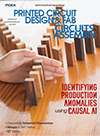News
News
The Impact of PCB Surface-Finish on Pb-free Solder Joint Voiding
Published: 12 March 2007
by Dr. Renzhe Zhao
Much research work has been conducted into the cause of voiding the materials relationship to voiding. When using SAC alloys, to achieve the desired wetting and ultimate interconnection, the fluxes in the paste formulations have to operate at higher temperatures than those of their SnPb counterparts. Not only do the fluxes work harder, the SAC alloys also have a higher surface tension than SnPb, increasing the possibility that unwanted volatiles are trapped within the molten solder. These volatiles cannot escape as easily, and voids are created when these compounds remain in the body of the solder once the material is solidified. Previously published reports outline the benefits of utilizing a low voiding solder paste formulation to alleviate both mechanical and electrical issues associated with Pb-free solder joint void formation. Using a low voiding solder paste formulation serves to significantly reduce the incidence of voiding, but there may also be other factors that should be considered for void reduction and improved long-term reliability.
Recent research has revealed that not only do solder paste flux and SAC alloy selection have an impact on the volume and size of Pb-free solder joint voids, but the pad surface finish plays a major role as well. For the purposes of the study, scientists focused on the effects of materials parameters only – and not process parameters – on voiding. These included the Pb-free alloy type, PCB pad finish and the content of the flux medium constituent. The research compared a SAC with a Sn-Ag solder alloy and evaluated various PCB pad finishes (bare copper, OSP copper, immersion silver and AuNi) along with four different levels of the flux medium component. Voiding levels were measured in the solder joints/solder bumps from three different BGA components: a BGA56, TBGA132 and a UCSP98.
The results of the research revealed that the amount of voiding was affected by the flux formulation, the surface finish (bare copper and OSP resulted in more voiding than AuNi or immersion silver finishes) and solder alloy (SnAg solder produced solder joints with much fewer voids than those produced using a SnAgCu solder). Although further study is required, these data would suggest that using a SnAg alloy or at least an alloy such as SAC305 with a lower concentration of copper would serve to significantly reduce void levels in Pb-free solder joints. It should be noted, however, that SnAg, while producing lower voiding levels, does require additional analysis to assess long-term reliability.
But what about the surface finish? Why were the copper and OSP finishes inferior to those of NiAu or immersion silver? One likely explanation centers on wetting speeds of the different surfaces. When attempting to wet onto copper, the spread factor is less because the surface tension or contact angle is higher with solder onto copper than that of solder onto gold. In other words, the speed at which the flux will clean the surface and the solder wet across the pad is slower with copper and much faster with gold. With slower wetting, the likelihood of more volatiles being trapped is high and, therefore, void creation may be increased. While it is not practical to suggest that all manufacturers migrate to ENIG finished pads, this surface finish clearly gave the best results. This cannot be considered the definitive solution, however, as there are other process and reliability issues – such as “black pad” during reflow – that are associated with ENIG. For those firms that will continue to use bare copper or OSP-finish pads, low-voiding formulation solder pastes will give better results than standard Pb-free pastes, as these advanced materials’ flux formulations provide improved cleaning, which results in fewer voids.
As we move through the Pb-free labyrinth, we continue to uncover more potential challenges – and solutions – within this unique manufacturing environment. Our company maintains that, although some voiding may be acceptable, taking all necessary measures to reduce voiding is the best and most reliable approach. Clearly, the optimum Pb-free voiding result will come from a multi-faceted materials solution: the right flux chemistry, the right surface finish and the right alloy.
Renzhe Zhao, Ph.D., is a senior applications engineer at Henkel’s Electronics Group.







